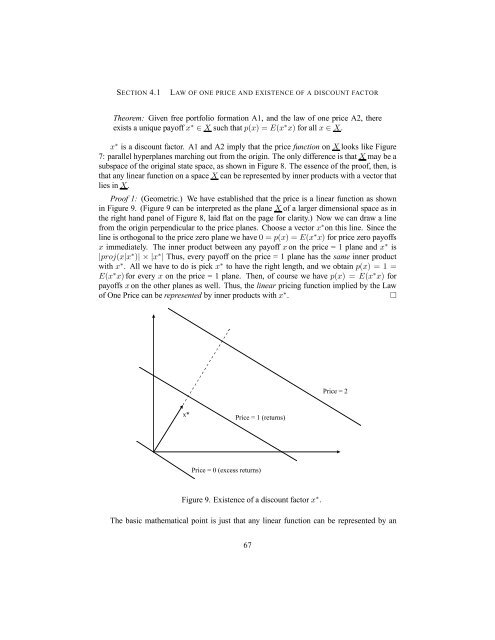Asset Pricing John H. Cochrane June 12, 2000
Asset Pricing John H. Cochrane June 12, 2000
Asset Pricing John H. Cochrane June 12, 2000
You also want an ePaper? Increase the reach of your titles
YUMPU automatically turns print PDFs into web optimized ePapers that Google loves.
SECTION 4.1 LAW OF ONE PRICE AND EXISTENCE OF A DISCOUNT FACTOR<br />
Theorem: Given free portfolio formation A1, and the law of one price A2, there<br />
exists a unique payoff x ∗ ∈ X such that p(x) =E(x ∗ x) for all x ∈ X.<br />
x∗ is a discount factor. A1 and A2 imply that the price function on X looks like Figure<br />
7: parallel hyperplanes marching out from the origin. The only difference is that X may be a<br />
subspace of the original state space, as shown in Figure 8. The essence of the proof, then, is<br />
that any linear function on a space X can be represented by inner products with a vector that<br />
lies in X.<br />
Proof 1: (Geometric.) We have established that the price is a linear function as shown<br />
in Figure 9. (Figure 9 can be interpreted as the plane X of a larger dimensional space as in<br />
the right hand panel of Figure 8, laid flat on the page for clarity.) Now we can draw a line<br />
from the origin perpendicular to the price planes. Choose a vector x∗on this line. Since the<br />
line is orthogonal to the price zero plane we have 0=p(x) =E(x∗x) for price zero payoffs<br />
x immediately. The inner product between any payoff x on the price = 1 plane and x∗ is<br />
|proj(x|x∗ )|×|x∗ | Thus, every payoff on the price = 1 plane has the same inner product<br />
with x∗ . All we have to do is pick x∗ to have the right length, and we obtain p(x) =1=<br />
E(x∗x) for every x on the price = 1 plane. Then, of course we have p(x) =E(x∗x) for<br />
payoffs x on the other planes as well. Thus, the linear pricing function implied by the Law<br />
of One Price can be represented by inner products with x∗ . ¤<br />
x*<br />
Price = 1 (returns)<br />
Price = 0 (excess returns)<br />
Figure 9. Existence of a discount factor x ∗ .<br />
Price = 2<br />
The basic mathematical point is just that any linear function can be represented by an<br />
67
















